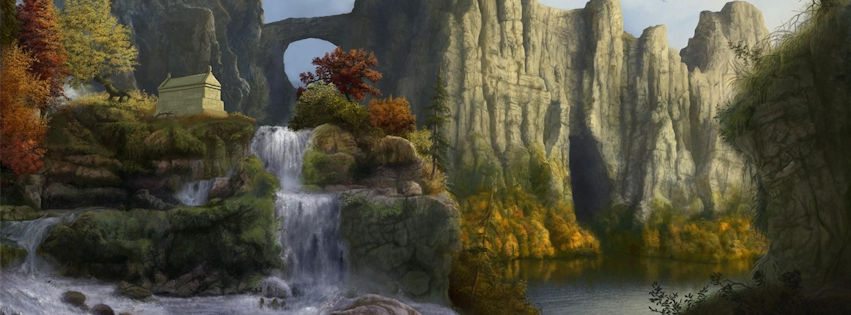Bloodsnow Valley
Encompassing the massive open space to the west of the Nilfshard Forest, Bloodsnow Valley is home to a diverse amount of wildlife during the (brief) summer months. Small, rolling hills slowly give way to the Frostheim Mountain Range on it's northern border, as well as the twin peaks of Skycrag to the southwest. Somewhere along it's border with the mountains lies the not-so-hidden entrance to the lair of Hoarfrost, Storm of Ruin, as well as access to the only known contiguous above-ground passage through the Frostheim Mountain Range to Last Hope and the wasteland beyond.
Geography
The geography of Bloodsnow is incredibly diverse, moreso in the winter months when everything is covered in a thick sheet of snow and ice. Nearing the various mountain ranges and peaks, the valley becomes far more dense with stone as it transitions to rolling hills. Nearer Nilfshard Forest, trees appear in abundance, and remain a feature of much of the valley.
Several fjords exist within the valley, evidence of glacial runoff in times past; none more famous than Troll's Fjord. Many of these fjords have permanent or semi-permanent settlements from various indigenous peoples, and almost all of them have encampments set up for mining operations during the habitable months. The fjords themselves are incredibly deep, with estimates indicating some have depths in excess of two thousand feet, indicating just how deep the ancient glaciers cut into the bedrock; these deep-water lakes and river systems are home to a plethora of fish and wildlife, as well as giving rise to a number of local legends about sea monsters, pre-historic creatures, or even behemoths of The Old World.
Several fjords exist within the valley, evidence of glacial runoff in times past; none more famous than Troll's Fjord. Many of these fjords have permanent or semi-permanent settlements from various indigenous peoples, and almost all of them have encampments set up for mining operations during the habitable months. The fjords themselves are incredibly deep, with estimates indicating some have depths in excess of two thousand feet, indicating just how deep the ancient glaciers cut into the bedrock; these deep-water lakes and river systems are home to a plethora of fish and wildlife, as well as giving rise to a number of local legends about sea monsters, pre-historic creatures, or even behemoths of The Old World.
Ecosystem Cycles
Bloodsnow Valley is the site of some of the largest migrations in all of Kermoria, as massive herds of pack animals (namely caribou) trek across it each year, moving from meadow to meadow during the spring and summer months in search of lichen and moss. Understandably, this migration brings predators from across the continent, looking for an easy meal, as well as nearly every indigenous tribe sending their hunters to gather as much meat for the upcoming winter as possible. This migration and hunting season may actually put more life into one place at one time than anywhere else in Kermoria, even rivalling or exceeding that of Snaketail Delta thousands of miles to the south. Estimates vary greatly, but some members of the Royal Society for the Exploration of the Natural and Physical World believe the great herds of caribou may exceed more than a million in number, and some estimates are nearly double that.
During the late autumn months, shortly before the ice begins to form along the fjords and waterways of the valley, thousands upon thousands of salmon make their trek from The Frigid Depths inland to spawn, a one-way journey for many of them. This mass of fish brings more life, and more predators, into the area, as many of the hibernating species (namely bears), preparing for their slumbers, are eager to pack on fat and protein for the upcoming winter months.
The annual migration of salmon (known as the salmon run) is also an important event for the local troll and giant populations; the giants come down from the mountains to gather fish en masse for the coming winter, and the trolls native to the valley and the fjords, normally solitary, use this time as both a hunting bounty and courtship ritual, spawning the next true generations of trolls (vice spawning through the natural regenerative process as limbs are removed).
During the late autumn months, shortly before the ice begins to form along the fjords and waterways of the valley, thousands upon thousands of salmon make their trek from The Frigid Depths inland to spawn, a one-way journey for many of them. This mass of fish brings more life, and more predators, into the area, as many of the hibernating species (namely bears), preparing for their slumbers, are eager to pack on fat and protein for the upcoming winter months.
The annual migration of salmon (known as the salmon run) is also an important event for the local troll and giant populations; the giants come down from the mountains to gather fish en masse for the coming winter, and the trolls native to the valley and the fjords, normally solitary, use this time as both a hunting bounty and courtship ritual, spawning the next true generations of trolls (vice spawning through the natural regenerative process as limbs are removed).
Localized Phenomena
The relatively open, tree-less areas of Bloodsnow Valley offer unparalleled views of the borealis, an unexplained cosmological event causing the sky to scatter into rainbow hues at night. Local tribes have several explanations for this incredible phenomenon, most being divine in nature. Scientists at the Barrileaux Observation Post, to the north of the valley, have several theories involving light from the various moons and celestial bodies causing the borealis, though no theory has yet to be proven. Regardless of the explanation, tourists and locals alike are often mesmerized by it's appearance, with one traveler reporting it was the 'most beautiful thing ever seen on this planet'.
Type
Valley
Location under
Included Locations
Owner/Ruler
Inhabiting Species





Comments